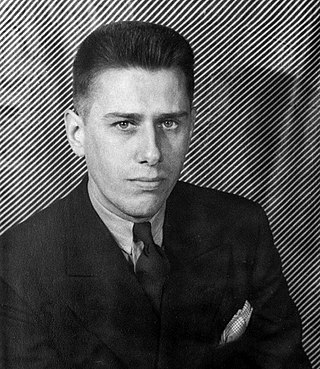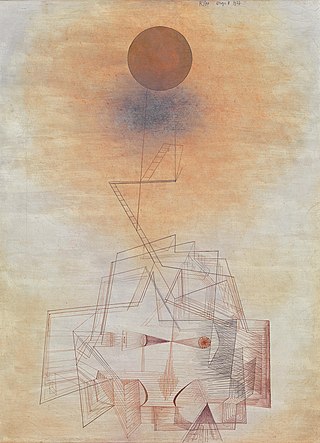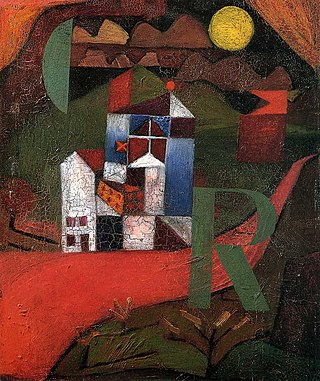
Paul Klee was a Swiss-born German artist. His highly individual style was influenced by movements in art that included expressionism, cubism, and surrealism. Klee was a natural draftsman who experimented with and eventually deeply explored color theory, writing about it extensively; his lectures Writings on Form and Design Theory, published in English as the Paul Klee Notebooks, are held to be as important for modern art as Leonardo da Vinci's A Treatise on Painting was for the Renaissance. He and his colleague, Russian painter Wassily Kandinsky, both taught at the Bauhaus school of art, design and architecture in Germany. His works reflect his dry humor and his sometimes childlike perspective, his personal moods and beliefs, and his musicality.

Indigenous Australian art includes art made by Aboriginal Australians and Torres Strait Islanders, including collaborations with others. It includes works in a wide range of media including painting on leaves, bark painting, wood carving, rock carving, watercolour painting, sculpting, ceremonial clothing and sandpainting. The traditional visual symbols vary widely among the differing peoples' traditions, despite the common mistaken perception that dot painting is representative of all Aboriginal art.

Ben Shahn was an American artist. He is best known for his works of social realism, his left-wing political views, and his series of lectures published as The Shape of Content.

transition was an experimental literary journal that featured surrealist, expressionist, and Dada art and artists. It was founded in 1927 by Maria McDonald and her husband Eugene Jolas and published in Paris. They were later assisted by editors Elliot Paul, Robert Sage, and James Johnson Sweeney. After the Second World War, the publishing license of transition was transferred from the Jolases and McDonald to Georges Duthuit who capitalized the title to Transition and changed its focus.

Robert Indiana was an American artist associated with the pop art movement.

Paul Cadmus was an American artist widely known for his egg tempera paintings of gritty social interactions in urban settings. He also produced many highly finished drawings of single nude male figures. His paintings combine elements of eroticism and social critique in a style often called magic realism.

An arrow is a graphical symbol, such as ← or →, or a pictogram, used to point or indicate direction. In its simplest form, an arrow is a triangle, chevron, or concave kite, usually affixed to a line segment or rectangle, and in more complex forms a representation of an actual arrow. The direction indicated by an arrow is the one along the length of the line or rectangle toward the single pointed end.

Willi Baumeister was a German painter, scenic designer, art professor, and typographer. His work was part of the art competitions at the 1928 Summer Olympics and the 1932 Summer Olympics.
Otto Nebel was a German painter born in Berlin, Germany.

Paul Klee Notebooks is a two-volume work by the Swiss-born artist Paul Klee that collects his lectures at the Bauhaus schools in 1920s Germany and his other main essays on modern art. These works are considered so important for understanding modern art that they are compared to the importance that Leonardo's A Treatise on Painting had for Renaissance. Herbert Read called the collection "the most complete presentation of the principles of design ever made by a modern artist – it constitutes the Principia Aesthetica of a new era of art, in which Klee occupies a position comparable to Newton's in the realm of physics."
Le petit picador jaune is an oil on wood painting by the Spanish artist Pablo Picasso, which he created in 1889 at the age of eight. It is considered to be the earliest known surviving work by the artist. The painting is a colourful representation of a Spanish bullfight, a subject which Picasso repeatedly returned to throughout his career.

Twittering Machine is a 1922 watercolor with gouache, pen-and-ink, and oil transfer on paper by Swiss-German painter Paul Klee. Like other artworks by Klee, it blends biology and machinery, depicting a loosely sketched group of birds on a wire or branch connected to a hand-crank. Interpretations of the work vary widely: it has been perceived as a nightmarish lure for the viewer or a depiction of the helplessness of the artist, but also as a triumph of nature over mechanical pursuits. It has been seen as a visual representation of the mechanics of sound.

Death and Fire, known in German as Tod und Feuer, is an expressionist painting by Paul Klee, from 1940. It is on display at Zentrum Paul Klee, in Bern.

Limits of Reason is a 1927 painting by Paul Klee (1879-1940). It is in the permanent collection of the Pinakothek der Moderne—Pinakothek of modern art—in central Munich's Kunstareal.

Ad Parnassum is a pointillist painting by Swiss-born artist Paul Klee. The painting is currently in the Kunstmuseum Bern.

Villa R is an oil-on-carton painting from 1919 by the Swiss-born German artist Paul Klee.

In the Magic Mirror is an abstract oil painting produced in 1934 by the Swiss-based German artist Paul Klee. It is now in the collection of the Art Institute of Chicago.

Cat and Bird is a painting by Swiss German painter Paul Klee, created in 1928. It was made when Klee was a teacher at the Bauhaus Dessau. The painting depicts the wide face of a stylized cat with a small bird perched on its forehead. It is held in the Museum of Modern Art, in New York.

Heroic Roses, known in German as Heroische Rosen, is an oil on stained canvas expressionist painting by Swiss-German painter Paul Klee, from 1938. It is held in the Kunstsammlung Nordrhein-Westfalen, in Düsseldorf.

















